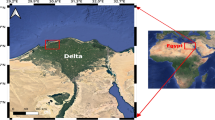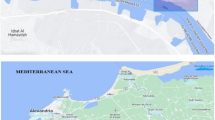Abstract
Diatomaceous earth is a natural material used in the food and beverage industry for filtration. In this paper, the radioactivity analyses and radiological risk estimation for 73 DE samples were conducted. The activity concentration of 226Ra, 232Th, and 40K was found to be in the range (5–164) Bq kg−1, (2–120) Bq kg−1, (19–1480) Bq kg−1, respectively. Absorbed gamma doses were in the range (8–172) nGy h−1. The total annual effective dose for workers was found to be in the range (0.011–0.217) mSv. Results indicate there is no particular radiation risk for workers and the public.


Similar content being viewed by others
References
Osmanlioglu AE (2007) Natural diatomite process for removal of radioactivity from liquid waste. Appl Radiat Isot 65:17–20. https://doi.org/10.1016/j.apradiso.2006.08.012
Farmer CN, Kathren RL, Christensen C (2008) Radioactivity in fossils at the Hagerman Fossil Beds National Monuments. J Environ Radioact 99:1355–2359. https://doi.org/10.1016/j.jenvrad.2008.02.004
Dlugosz-Lisiecka M, Tyborowski D, Krystek M (2021) Radioactive fossils: the uranium anomaly and its paleobiological implication. Chemosphere 285:131444. https://doi.org/10.1016/j.chemosphere.2021.131444
Cook GT, MacKenzie AB (2014) Radioactive isotope analyses of skeletal minerals in forensic science: a review of uses and potential uses. Int J Legal Med 128:685–698. https://doi.org/10.1007/s00414-014-0970-8
Reka AA, Pavlovski B, Fazlija E et al (2021) Diatomaceous earth: characterization, thermal modification, and application. Open Chem 19:451–461. https://doi.org/10.1515/chem-2020-0049
Akhoundi M, Bruel C, Izri A (2019) Harmful effects of bed bug-killing method of diatomaceous earth on human health. J Insect Sci 19(5):13; 1–2. https://doi.org/10.1093/jisesa/iez095
Janićijević J, Krajišnik D, Čalija B et al (2014) Inorganically modified diatomite as a potential prolonged-release drug carrier. Mater Sci Eng C 42:412–420. https://doi.org/10.1016/j.msec.2014.05.052
Fu W, Wichuk K, Brynjόlfsson S (2015) Developing diatoms for value-added products: challenges and opportunities. N Biotechnol 32(6):548–551. https://doi.org/10.1016/j.nbt.2015.03.016
Lutyński M, Sakiewicz P, Lutyńska S (2019) Characterization of diatomaceous earth and Halloysite resources of Poland. Minerals 9:670. https://doi.org/10.3390/min9110670
Paules D, Hamida S, Lasheras RJ et al (2018) Characterization of natural and treated diatomite by Laser-Induced Breakdown Spectroscopy (LIBS). Microchem J 137:1–7
Reka AA, Anovski T, Bogoevski S, Pavlovski B, Boškovski B (2014) Physical-chemical and mineralogical-petrographic examinations of diatomite from deposit near village of Rožden. Republic Macedonia Geol Maced 28(2):121–126
Spasovski O, Šijakova-Ivanova T, Doneva B, Spasovski D (2016) New findings for diatomite (diatomaceous earth) between the villages of Manastir and Bešište (Mariovo). Geol Maced 30(2):167–171
Mannetje A’t, Steenland K, Attfield M et al (2002) Exposure-response analysis and risk assessment for silica and silicosis mortality in a pooled analysis of six cohorts. Occup Environ Med 59:723–728
Korunić Z (2016) Overview of undesirable effects of using diatomaceous earths for direct mixing with grains. Pest Phytomed (Belgrade), 31(1–2):9–18. https://doi.org/10.2298/PIF1602009K
Kuzmanović P, Knežević RJ, Mrđa D et al (2022) Radioactivity of fertilizers used in Serbia and dose assessments for workers in the industry. J Radioanal Nucl Chem. https://doi.org/10.1007/s10967-022-08646-x
Kuzmanović P, Todorović N, Forkapić S et al (2020) Radiological characterization of phosphogypsum produced in Serbia. Radiat Phys Chem 166:108463. https://doi.org/10.1016/j.radphyschem.2019.108463
Kuzmanović P, Todorović N, Mrđa D et al (2019) Radiation exposure to zircon minerals in Serbian ceramic industries. J Radioanal Nucl Chem 322:949–960. https://doi.org/10.1007/s10967-019-06743-y
UNSCEAR (2000) Sources and effects of ionizing radiation. Report to the General Assembly, with Scientific Annexes. United Nations Scientific Committee on the Effects of Atomic Radiation, United Nations, New York.
UNSCEAR (2008) Sources and effects of ionizing radiation United Nations Scientific Committee on the Effects of Atomic Radiation, United Nations, New York.
Seixas NS, Heyer NJ, Welp EAE, Checkoway H (1997) Quantification of historical dust exposures in the diatomaceous earth industry. Ann occup Hyg 41(5):591–604
Chronic Toxicity (2005) Summary silica (Crystalline, Respirable). Available at https://oehha.ca.gov/media/downloads/air/document/silicacrelfinal.pdf
ICRP (K. Eckerman, J. Harrison, H-G. Menzel, C.H. Clement) (2012) Annals of the ICRP, ICRP Publication 119, Compendium of Dose Coefficients based on ICRP 60 Publication, Volume 41.
EURATOM (2014) Council Directive 2013/59/Euratom of 5 Dec. 2013 Laying down basic safety standards for protection against the dangers arising from exposure to ionising radiation, and repealing directives 89/618/Euratom, 90/641/Euratom, 96/29/Euratom, 97/43/ Euratom and 2003/122/Euratom. L13, vol 57. ISSN: 1977–0677. https://ec.europa.eu/energy/sites/ener/files/documents/CELEX-32013L0059-EN-TXT.pdf
Official Gazette RS 86/11 and 50/18 (2018) Rulebook on Limits of Exposure to Ionizing Radiation and Measurements for Assessment of the Exposure Levels (in Serbian)
Van TT, Bat LT, Nhan DD et al (2019) Estimation of radionuclide concentrations and average annual committed effective dose due to ingestion for the population in the Red River Delta. Vietnam Environ Manage 63:444–454. https://doi.org/10.1007/s00267-018-1007-8
Savitri PP, Murty TS, Sudhakar J et al (2020) Ingestion dose due to 226Ra, 228Ra, and 40K in the plant origin food materials grown around BARC. Visakhapatnam Radiat Prot Environ 43(3):140–147
Giri S, Jha VN, Singh G, Tripathi RM (2013) Estimation of annual effective dose due to ingestion of natural radionuclides in foodstuffs and water at a proposed uranium mining site in India. Int J Radiat Biol 89(12):1071–1078. https://doi.org/10.3109/09553002.2013.817707
Jayasinghe C, Molligoda V, Attanayaka T, Waduge V (2019) Estimation of annual effective dose due to ingestion of radioactive elements in Sri Lankan common meal plans. Environ Geochem Health 41:1123–1129. https://doi.org/10.1007/s10653-018-0200-2
Official Gazette RS 36/2018 (2018) Pravilnik o granicama sadržaja radionuklida u vodi za piće, životnim namirnicama, stočnoj hrani, lekovima, predmetima opšte upotrebe, građevinskom materijalu i drugoj robi koja se stavlja u promet (in Serbian).
Acknowledgements
The authors gratefully acknowledge the financial support of the Ministry of Science, Technological Development and Innovation of the Republic of Serbia, Grant No. 451-03-47/2023-01/200125.
Author information
Authors and Affiliations
Contributions
JKR: Conceptualization, Software, Validation, Investigation, Formal analysis, Writing—original draft. JH: Conceptualization, Methodology, Investigation. DM: Conceptualization, Methodology, Software, Validation. SF: Supervision, Writing—review & editing. KB: Conceptualization, Writing—review & editing. PKc: Investigation, Writing—review & editing. Danijel Velimirovic: Investigation, Validation, Writing—review & editing.
Corresponding author
Ethics declarations
Conflict on interest
The authors declare that they have no conflict of interest.
Additional information
Publisher's Note
Springer Nature remains neutral with regard to jurisdictional claims in published maps and institutional affiliations.
Rights and permissions
Springer Nature or its licensor (e.g. a society or other partner) holds exclusive rights to this article under a publishing agreement with the author(s) or other rightsholder(s); author self-archiving of the accepted manuscript version of this article is solely governed by the terms of such publishing agreement and applicable law.
About this article
Cite this article
Radic, J.K., Hansman, J., Mrdja, D. et al. Diatomaceous earth: radiological characterization and risk assessment. J Radioanal Nucl Chem 332, 3227–3234 (2023). https://doi.org/10.1007/s10967-023-09018-9
Received:
Accepted:
Published:
Issue Date:
DOI: https://doi.org/10.1007/s10967-023-09018-9




